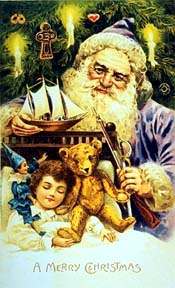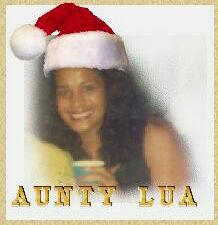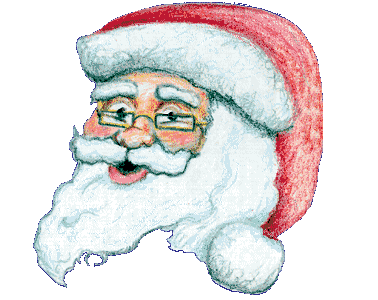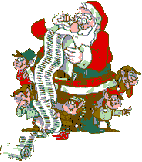|
|
|

 |
patience is a virtue - please practice and let the pictures and music load!
 | Aunty Lua is your Santa's Helper... mind her or she'll email Santa telling him you weren't nice! E-mail Santa your wishlist! - He'll be writing back to you in December! |

Not many people know the origin of Santa Claus, a man sainted for his gifts, generosity and kindness to the poor, starving, helpless and sick, giving away all his worldly goods for their benefit over 1500 years ago. A wonderful example for hundreds of generations of people, and even today, of the spirit of giving, caring and helping your fellow man. Did you know that Santa Claus, or Kris Kringle, was St. Nicholas who was born in Turkey?
Orphaned at an early age, when Santa Claus received his inheritance, he gave it all away as food, gifts and money to the poor people of Turkey, his homeland. Continuing to give and care was Santa Claus's life, so he later became the Bishop of Myra who was well known for his gifts of miracles, as well as his kindness and generosity to all mankind. What better example of the celebration of the Christmas spirit than a man, sainted, who gave everything to help his fellow man?St. Nicholas, Santa Claus, Father Christmas, or Pere Noel, there's no doubt his gift keeps giving and living beyond time.
How The Santa Claus Legend Began.
The custom of giving gifts on a special day in winter was practiced before Christianity was well established, Saint Nicholas became a symbol of the custom among Christians. During the Reformation, Protestants substituted nonreligous characters for Saint Nicholas. America had a figure of Saint Nicholas on the front of their ship. The Dutch settlers maintained their custom of celebrating the saint's feast day on December 6. They told their children that the saint visited their homes and left gifts for the youngters on Saint Nicholas Eve. In time, English settlers adopted the legends and festivities associated with Saint Nicholas. English-speaking children spoke the dutch name for the saint, Sinterklaas, quickly and excitedly so that it sound like Santy Claus or Santa Claus.
Santa-like Characters In Other Countries.
Today, people in many parts of the world are familiar with the legend of Santa Claus. But he is primarily an American tradition. People in most countries have adopted other imaginary characters who supposedly bring gifts on a certain day of the year other than Christmas.
In the Netherlands and Belguim, Saint Nicholas visits homes on St. Nicholas Eve, December 5. He leaves small gifts in shoes that the children put near the fireplace, to be opened on St. Nicholas Day, December 6. He often is accompanied on these visits by a character named Black Pete, who carries a birch rod to whip naughty children. People in Austria, Hungary, and parts of Germany also celebrate St. Nicholas Day.
In southern Germany, people usually say the Christkind (Christ Child) sends the gifts on Christmas Eve. But in Northern Germany, most people say the Weihnachtsman (Christmas Man) brings the presents. From the name Christkind came the character Kris Kringle, who gradually became identified with Santa Claus. In France, Pere Noel leaves small presents in homes on Christmas Eve. In Sweden, the Jultomten, an elf-like character, brings gifts on Christmas Eve. This elf is called Julenissen in Denmark and Norway.
| COUNTRY | NAME |
| British Isles | Father Christmas |
| China | Dun Che Lao Ren (dwyn-chuh-lau-oh-run) |
| Czechoslovakia | Svaty Mikalas |
| Denmark | Julemanden |
| France | Pere Noel or le petit Jsus |
| Germany | Saint Nicholas |
| Greece | Saint Nicholas |
| Italy | La Befana |
| Japan | Hoteiosho |
| Netherlands | Sinterklaas |
| Norway | Julebukk |
| Russia | Saint Nicholas |
| Spain | Balthazar |
| Sweden | tomte |
| Wales | Mari Ilwyd |
--The World Book Encyclopdia.
The Many Faces of Santa
Clement Moore, "A Visit from St. Nicholas" |
 | Santa Claus
|
|
Click on any area you wish to visit - don't forget to tell us what Christmas means to you and sign the Kiddie's Guestbook for Santa!
The Real Reason we celebrate Christmas. | Funstuff not just for Christmas! | Coloring Book | lots of Christmas pictures | Christmas Reading Room | Christmas Music | Angels, Angels, Angel! | E-mail Santa your wishlist! | tell us what Christmas means to you | send an e-card to a friend | Kiddie Christmas Guestbook | Kid Chat On-line|Kiddie Links
You may use this quick e-mail form to send Santa your email address. He'll send you a Christmas greeting!
 |
Send A Christmas Card to Family and Friends!

We'll tell you when we update this page if you join our mailing list!
Like this site? Tell your family and friend about it!